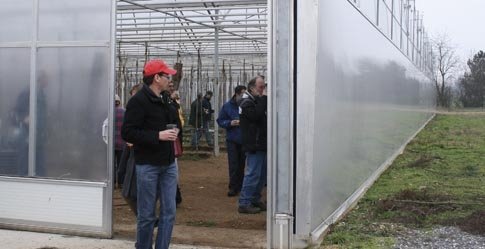
A farming operation in Austria has planted cherry trees in a greenhouse with the aim of having low-carbon-footprint cherries on the market in March.
In 2004, the farm established a biogas unit at Gänserndorf to produce electrical and thermal energy from corn, pig manure, potatoes, and a triticale and vetch mixture. This year, it is also using apples because of the low price of apples in Europe caused by a large crop. About a third of the thermal energy produced is used in the process of making biogas.
Farm director Bernhard Schabbauer said the farm sells electricity to the grid, and uses some of the thermal energy to heat water for the pig feed and to heat the worker housing, but it had more energy than it needed. After considering several possibilities, he came up with the idea of using the excess heat to grow cherries in a greenhouse.
The greenhouse covers half a hectare (54,000 square feet) of ground that was formerly pasture for cattle. The covering is a double layer of plastic with air between. The trees are Early Star, Samba, and Grace Star cherries on Gisela 5 rootstocks, which cost 7.5 euros (U.S.$9.75) per tree. Schabbauer bought one-year-old trees with few branches so that he could develop the trees himself and planted them in the winter of 2007. They are 60 centimeters (2 feet) apart, and Schabbauer is prepared to remove alternate trees if they become overcrowded.
Cold
Walls of the greenhouse can be opened up in the winter to expose the trees to cold and allow them to go dormant. “We think they need 30 to 40 days of cold weather.”
The greenhouse was closed up and heated starting in January after planting, and in February the trees were scored and sprayed with the plant hormone gibberellic acid 4/7, to encourage branching. Schabbauer said the trees developed very large leaves. The first trees bloomed on February 14. He used bumblebees for pollination, and the trees produced a few cherries in March, in their first leaf.
Schabbauer told members of the International Fruit Tree Association when they visited the greenhouse in late January that he hoped to have a commercial crop this March, in the second leaf. He was considering bringing potted sour cherry trees into the greenhouse during bloom to improve pollination. He planned to use four hives of bumblebees this year.
Although insect pests are not a problem in the greenhouse, the high humidity leads to serious disease pressure, he said. “We thought we can produce cherries the biological way, but when there are leaves on the trees, the humidity is very high, so you have no chance against fungal diseases.”
He applies copper to control bacterial diseases and said he’s considering installing ventilators to reduce the humidity.
Grant
The farm received an ecological agriculture grant from the European Union that paid for about 30 percent of the cost of building the greenhouse, which was about 52 euros per square meter (U.S.$6 per square foot). The total establishment cost, including the trees, posts, heating system, and technical building, was 320,000 euros (U.S.$416,000).
Schabbauer said the biogas-heated greenhouse should help reduce the farm’s carbon-dioxide emissions, and the cherries will have a smaller carbon footprint than Southern Hemisphere cherries that are available in Europe at that time of year.
He’s expecting a return to the farm of 10 to 12 euros per kilo for the cherries (about U.S.$6 per pound). In January, Chilean cherries were selling in Europe at a retail price of 1.50 euros per 100 grams (equivalent to U.S.$9 per pound). He hopes that within two or three years he’ll be harvesting 18 tons of cherries from the greenhouse, which would be the equivalent of more than 7 tons per acre.

Leave A Comment